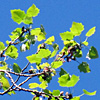Populus alba (White poplar) is a tall, deciduous tree with a broad pyramidal crown. Its bark is white and the leaves are dark green on their upper side and silvery-white underneath, imparting it with its characteristic shape. White poplar is a fast-growing but rather short-lived tree. It reaches a height of 27 m, and its maximal diameter at breast height is 2 m.
The roots of white poplar are superficial and long, and extend to a distance of 20-30 m from the trunk. If they are cut or injured by pests, shoots appear at the place of injury, and these quickly become mature trees.
The bark of the young tree is smooth and greenish-white to grayish with characteristic diamond-shaped spots. When the tree matures, the bark at the base of the trunk becomes fissured and blackish.
The wood of white poplar is white and soft. It is used around the world are as windbreaker in plantations and as a source of wood for the production of matches and crates. Its leaves serve as fodder for cattle. In Holland, the poplar, as well as the willow, are used for the manufacture of the traditional wooden shoes.
The leaves are broad at their base and narrow at the tip. The leaf margin has 3-5 lobes. The leaves are up to 15 cm long. The surface of the leaves is covered with white scales. On the upper side they create a thin layer, underneath they create a thick layer which gives this side its silvery-white color.
White poplar is a dioecious tree. The trees which are planted in ornamental gardens are almost all male trees, propagated by cuttings. The male trees have an elongated and narrow, 8 cm long, gray, spike-shaped inflorescence with red stamens. Dispersal of the pollen is by wind. The green inflorescences of the female trees dangle from the branches and are 8-10 cm long. Bloom occurs in the spring and the fruits ripen during the summer. The seeds are surrounded by dense downy hairs. They are dispersed by wind and are also carried by water currents.
The name of the Salicaceae family, to which the genus Populus belongs, apparently originates from Celtic, where the two-word phrase that comprises this name: “near water”, is characteristic of the habitat of trees from this family. The Latin name Populus and the English name poplar are an onomonopia, as in Hebrew (tzaftzefa), where the sound of the word imitates the whistling sound of the leaves when wind blows through them.
The origin of white poplar is in Europe and Asia, where it grows in regions with a temperate climate. The trees that are planted in groves for wood production are mostly hybrid trees with other poplar species, and the most common one is a hybrid with Populus tremuloides, that reachs a height of 40 m.
Poplar grows well in nature near rivers and in flooded areas. In dryer areas, including gardens and groves in Israel, large amounts of irrigation are necessary in order to sustain it and lead to its rapid growth. White poplar is known as an invasive tree in humid habitats of Australia.
The genus Populus includes 25-35 deciduous trees which all grow in the cold temperate regions of the Northern Hemisphere.
In Israel, attempts were made in the 1960s to plant poplars for wood production, and some researchers and farmers even expected them to produce 8 cubic meters annually per dunam. However, in spite of extensive irrigation and fertilization which the saplings received in agricultural soil, they did not achieve even one quarter of the yield expected by those who planted them. Plots of such trees were found in Yagur and Gonen.
In Israel, white poplar trees are planted as ornamental trees in gardens and near springs and rivers. They succeed with irrigation in the Golan Heights region, in the Galilee, the Jerusalem mountains, the coastal plain and the valleys. Because of the need for extensive irrigation, and due to the appearance of shoots at a large distance from the tree, it is planted to a much smaller extent today than in the past. It is not suitable and was not planted as a tree for forestation by the KKL (Jewish National Fund).
Written by Zvi Avni





